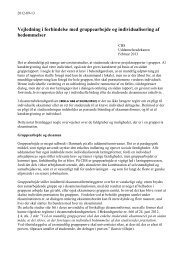Untitled - CBS Observer
Untitled - CBS Observer
Untitled - CBS Observer
You also want an ePaper? Increase the reach of your titles
YUMPU automatically turns print PDFs into web optimized ePapers that Google loves.
Trends in the chocolate<br />
confectionery market<br />
Premiumization<br />
Compared to other consumer-facing industries, the financial<br />
crisis has had a relatively soft impact on the chocolate<br />
confectionery industry. Despite falling disposable incomes,<br />
volatile commodity prices, and ever-increasing competition,<br />
the global chocolate retail market value has stayed flat, at<br />
a global market value of more than 100 billion US dollars.<br />
Some have taken this as a sign that even relatively expensive<br />
chocolate has become an affordable luxury that consumers<br />
treat themselves to in economic downturns. Consumers are<br />
thus more willing to treat themselves to high-end chocolates<br />
than more expensive luxury products like jewelry. As a result,<br />
the premium segment is expected to drive chocolate confectionery<br />
growth in most of the mature Western markets in the<br />
coming years. From 2011 to 2015, the retail value in Western<br />
Europe is expected to increase by six percent annually.<br />
Regional champions<br />
The industry’s largest players have shown an increased interest<br />
in regional premium and ultra-premium brands. Compa-<br />
nies within the premium segments have become particularly<br />
attractive as the largest companies, such as Mars and Mondelez<br />
International, are seeking growth opportunities outside<br />
the traditional mass-market segments. The major players have<br />
also turned their attention toward smaller local actors with a<br />
strong position within a niche segment. The acquisitive strategies<br />
by the larger players have served to push up the trading<br />
prices of smaller companies, making it difficult for other<br />
companies to bid for available assets. Typically, the acquired<br />
companies are marketed separately under their original brand<br />
names after the acquisition to avoid affiliation with the acquirer.<br />
The acquirer thus uses local niche players to leverage<br />
their processes and know-how in their home markets.<br />
Cultural consumption<br />
Western Europe and the US still constitute the major markets<br />
for chocolate manufacturers, as chocolate consumption<br />
remains high both in absolute and relative terms. The US,<br />
for instance, eats more chocolate by volume than any other<br />
country in the world, whilst the mainly European countries<br />
have the highest chocolate consumption per capita. Howev-<br />
er, mature markets show relatively sluggish growth rates. As<br />
a consequence, the global companies have started to widen<br />
their horizon and look toward the emerging economies<br />
where chocolate consumption is still low. A major impediment<br />
to this strategy is the very culturally specific pattern of<br />
consumption that exists in different markets. One may tend to<br />
think of chocolate as one market, but in fact there are several<br />
major cultural differences in consumption. A thorough appreciation<br />
of these differences is important to be successful in<br />
new markets, and several resourceful companies have tried<br />
in vain to educate consumers in distant markets about the<br />
consumption patterns of the companies’ home markets.<br />
Seasonality of consumption<br />
Cultural differences also manifest themselves in the choice<br />
of occasions for chocolate consumption. In many countries,<br />
chocolate is associated almost exclusively with holidays and<br />
other seasonal traditions. Seasonal specialties are thus becoming<br />
increasingly important sources of revenue for chocolate<br />
manufacturers. Globally, Easter is the largest “chocolate<br />
season” with Easter eggs and bunnies as consumer favorites.<br />
In fact, Easter-related product launches rose 45 percent during<br />
2011 alone. However, Easter is not the only important chocolate-related<br />
holiday. Christmas has also become a significant<br />
season for chocolate producers worldwide, while Chinese<br />
New Year and Valentine’s Day are growing in importance.<br />
A chocolate a day<br />
Health concerns are naturally becoming a major factor in<br />
chocolate purchasing behavior. Experts anticipate that the increased<br />
focus on health-related issues will only become more<br />
outspoken in the future as governments try to combat obesity.<br />
In response, the emphasis on the health benefits of the darker<br />
chocolates in particular has become more prominent. Other<br />
manufacturers have started to produce smaller bars, sharing<br />
packs and other forms of portion controls as a way to combat<br />
obesity and attract health-conscious consumers. As much as<br />
10 percent of all product launches in Europe during 2011<br />
were marketed as vegetarian, while another seven percent<br />
were marketed as organic.<br />
10 <strong>CBS</strong> CASE COMPETITION 2013<br />
11
















